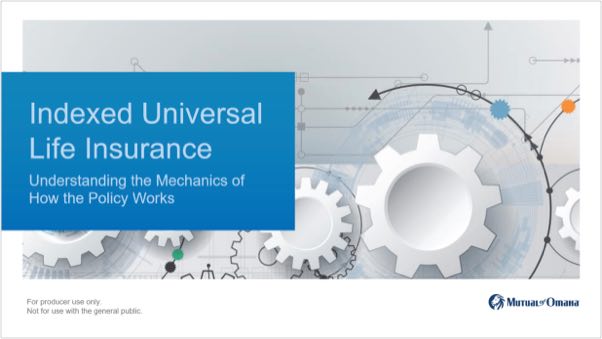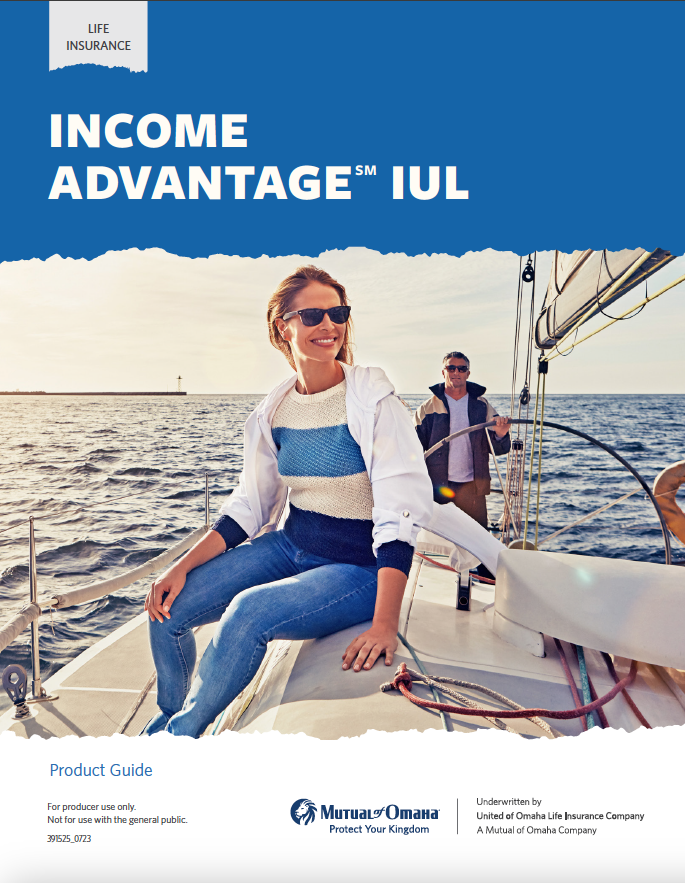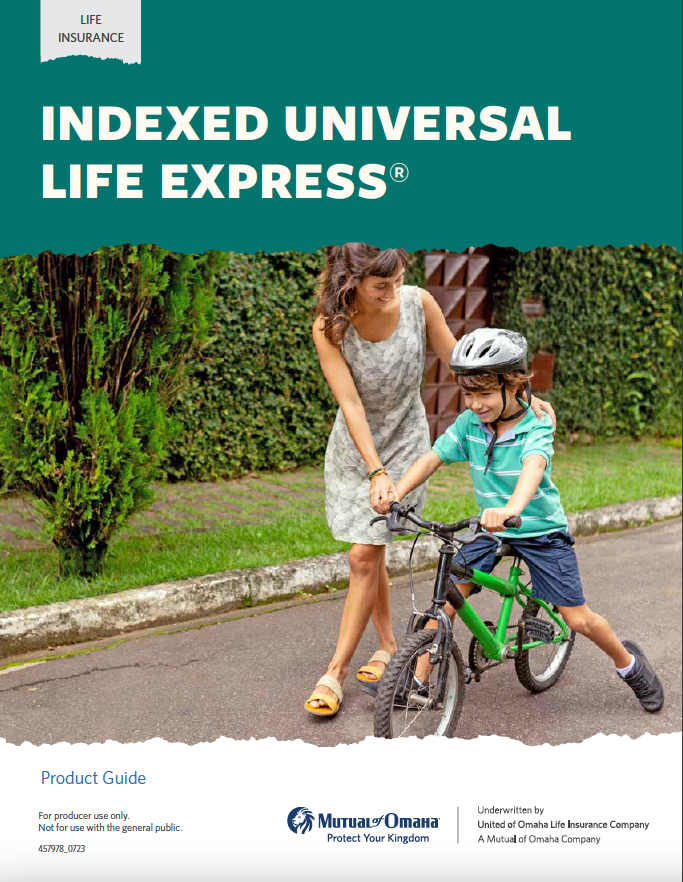Viewing content for
 IUL Product Training
IUL Product Training
 State Selected
State Selected
 State Selection
State Selection
Select Your State:
We want to make sure you get the appropriate information on products approved for sale in your state.
 Product Unavailable
Product Unavailable
 Calculator - Indexed Universal Life Training
Calculator - Indexed Universal Life Training

Our IULs should be your go-to jam, because they’re the perfect blend of simple and strong. That’s a combo that’ll have your sales rocking!
Check out how our IUL jams stack up against the competition:
- Income Advantage IUL - Accumulation-focused IUL, intended to help build cash value
- Life Protection Advantage IUL - Protection-focused IUL that is guaranteed to carry to age 90 or beyond*
- Long Term-Care Rider - Available for both IULs, this rider provides long-term care protection, helping to preserve the value of the estate
 IUL University - Indexed Universal Life
IUL University - Indexed Universal Life
IUL University
View our series of short, easy-to-follow training modules to learn all about indexed universal life insurance and our two product offerings.
How Does IUL Work?
Learn more about how indexed universal life insurance policies function.
Length: 13:21
How Does Income Advantage IUL Work?
Discover more about our accumulation-focused IUL product.
Length: 015:09
How Does Life Protection Advantage IUL Work?
Find out how our protection-focused IUL works.
Length: 11:48
How Does the Long-Term Care Rider Work?
Learn how the rider works and how it can benefit your IUL clients.
Length: 9:36
 Sales Tools - Indexed UL Training
Sales Tools - Indexed UL Training
Sales Tools
 Brochure and Producer Guide - Indexed UL Training
Brochure and Producer Guide - Indexed UL Training
Income Advantage IUL
Life Protection Advantage IUL
 Web Content Viewer
Web Content Viewer
Indexed Universal Life Express
 Sales Tools Materials Search - Indexed UL Training
Sales Tools Materials Search - Indexed UL Training
Use the materials search to find additional sales materials for our indexed universal life insurance products.
Note: State-specific materials are used in some states. State-specific versions are available using the materials search on Sales Professional Access. Products may not be approved in all states. Please refer to the state product approval grid.
 Who Buys IUL Categories - Indexed Universal Life
Who Buys IUL Categories - Indexed Universal Life
Who Buys Indexed Universal Life Insurance?
Why They Buy |
Where to Prospect |
How to Prospect |
|
|---|---|---|---|
Younger Working Professionals |
|
|
|
Pre-retirees |
|
|
|
Retirees |
|
|
|
Small Business OwnersSmall business owners should consult their tax advisor or attorney, if applicable. |
|
|
|
 Glossary - Indexed Universal Life
Glossary - Indexed Universal Life
Glossary
A
Account value
The sum of the fixed account value and the index account value.
Accumulation value
The sum, as of any date, of the values in the short-term holding account, the fixed account, and the index account.
Annual point-to-point crediting
A method of calculating index interest in which the value of the index is captured on the date the segment is created and then compared to the value when the segment matures one year later. The prior year's index value is subtracted from the current year's index value to determine how much the index has changed over that year. The difference is then divided by the beginning index value to determine the percentage of change that took place during the year. The participation rate and the cap are then applied to determine the index interest rate to be credited to the funds currently in that segment.
(Ending Value of Index – Beginning Value of Index) / Beginning Value of Index
C
Cap rate
The maximum interest rate used in the calculation of the index credit for each segment. The cap rate is declared by the company monthly. Once a segment is created, the cap rate is guaranteed until the segment matures.
Cash value
The amount that may be available through loans or withdrawals, as defined in the contract.
Credit (Index)
The amount credited to a segment based on the index performance and the cap, the floor, and the participation rate for the chosen index crediting strategy. The index credit is calculated and added to the segment at the end of an index period. No index credit will be given if funds are withdrawn before the end of the index period.
Crediting date
The date the index credit is calculated for each segment at the end of the 12-month period. This will always be the 10th of each month.
Crediting method
The method used to calculate the index change. The index crediting method for Income Advantage and Life Protection Advantage is annual point-to-point.
Crediting strategy
A crediting strategy is an allocation choice by the insured as to how they would like to participate in the IUL. Income Advantage and Life Protection Advantage offer three index interest crediting strategies:
- 100 percent participation rate with a mid-range cap
- Higher participation rate (greater than 100 percent) with a lower cap
- Lower participation rate (less than 100 percent) with no cap
D
Downside protection
Even if the percentage change in the index is negative, the minimum crediting rate is zero percent.
F
Fixed account
An account that offers a fixed rate of interest declared by the company. The fixed account value is credited with the company's currently declared, non-guaranteed interest rate.
Fixed interest rate
The company's currently declared non-guaranteed interest rate. This rate applies to the fixed account.
Floor
The minimum interest rate used in the calculation of the index credit.
I
Index period
The 12-month period during which the index crediting is calculated. An index period begins when a segment is created (on the 10th of the month following the premium payment). At the end of an index period, a new index period begins, and any values in the segment will remain in the same segment, unless changed by the client.
Index interest
The percentage of interest credited to the accumulation value based on changes in the index after the crediting method (annual point-to-point) is applied.
L
Life expectancy
The probable number of years remaining in the life of an individual or class of persons determined statistically. For a life insurance policy, life expectancy is based on the age of the insured as of the day the policy is issued.
Loan (indexed)
A loan for which interest charged is declared in advance, while the interest credited is based on the underlying index performance. The interest charged on indexed loans is declared by the company but will never exceed 6 percent.
Loan (standard or fixed)
A loan in which the stated interest rates charged to the loan and credited to the account are fixed and not tied to the underlying performance of the index.
N
No-lapse protection period (long-term)
The duration the death benefit coverage is guaranteed as long as the client continues to pay the long-term no-lapse protection premium. This premium level is only available on Life Protection Advantage.
No-lapse protection period (short-term)
The duration the death benefit coverage is guaranteed as long as the client continues to pay the minimum initial premium payment. This premium level is available on both Income Advantage and Life Protection Advantage.
P
Participation rate
The percentage of the overall index return that will be used in the calculation of the index credit. The participation rate is declared by the company monthly. Once a segment is created, the participation rate is guaranteed until the segment matures.
S
Segment
A portion of an index account that may be credited interest based upon the performance of the index. A new segment is created on the 10th of each month. The policy may contain multiple segments at one time. Each segment will end or mature one year after it begins (on the segment maturity date).
Short-term holding account
Net premiums are initially placed in this account until they can be allocated on the 10th of the month following the premium payment.
 FAQs - Indexed Universal Life
FAQs - Indexed Universal Life
Frequently Asked Questions
Can crediting rate caps and participation rates change over time?
Yes. Caps and participation rates are dependent upon the economic environment, but will never drop below the guaranteed minimum levels as specified in the contract. These are declared by the company and can change as often as monthly.
Are the caps and participation rates the same for all IUL products?
No. Caps and participation rates will vary by product. Please refer to the Current Interest Rates section of the Sales Professional Access website for the current participation rates and caps for each product.
How is index interest calculated?
Our IUL products use one of the most straightforward index crediting methods in the industry - annual point-to-point. This crediting method calculates the index interest rate by comparing the S&P 500® value on the date a segment is created to the value one year later when the segment matures. The participation rate and the cap are then applied to determine the index interest rate to be credited to the funds currently in that segment.
Example: Below are three examples of how the interest amount to be used to credit would be calculated.
| Above-average Return for Index | Average Return for Index | Below-average Return for Index | |
|---|---|---|---|
Index Change |
30% |
11% |
3% |
No Cap 65% Participation |
19.5% |
7.15% |
1.95% |
12% Cap 100% Participation |
12% |
11% |
3% |
8% Cap 140% Participation |
8% |
8% |
4.2% |
* Participation rates and caps shown are for example purposes only. Please refer to the Current Interest Rates for current participation rates and caps for each product.
What is a segment?
A segment is a portion of an index account that may be credited interest based upon the performance of a market index.
When does a segment begin for my premium payment?
New segments are created on the 10th of each month. A policy may contain up to 12 segments per index interest crediting strategy. Each segment ends or matures, one year after it begins. Upon maturity, a new segment starts and any values in the new segment will use the same index interest crediting strategy, unless changed by the client.
What happens to funds received prior to the 10th of the month?
If money is received prior to a new segment start date, it will sit in the short-term holding account where it earns the same interest rate as the fixed account until the next segment start date.
Can term policies be converted to an indexed universal life policy?
Yes, the usual term conversion rules apply.
What's the difference between standard loans and indexed loans?
For standard loans, the interest charged and credited is known in advance. With indexed loans, interest charged is declared in advance; however, interest credited is based on the underlying index performance.
When applying for a loan, the client will be asked which type of loan they're applying for.
How do I decide which crediting strategy(ies) to recommend to my clients?
While these suggestions are by no means definitive, here are a few broad guidelines about which of your clients might be best for each crediting strategy:
- 100 percent participation rate with mid-range cap - Clients who believe the index will perform at an average or slightly above average rate might be more suited to select this strategy
- Higher participation rate with lower cap - Clients who believe the index will perform below the cap or below the index average might be more suited for this strategy
- Lower participation rate with no cap - Clients who believe the market will outperform the cap might be more suited for this strategy
- Fixed account - Clients who may not be comfortable with allocating all of their accumulation value to an index interest crediting strategy
How often can clients change their crediting strategy?
The crediting strategy can be changed as often as monthly for new money. For money already submitted, amounts can be moved once an existing segment matures. The policyowner can also transfer between the fixed and index account. Transfers from the fixed account to the index account are processed on the next allocation date. Transfers from the index account to the fixed account will be processed on the next segment maturity date.
What does "downside protection" mean?
Downside protection means that even if the market falls and the index change is negative, the client will be credited no less than the floor for that segment. For our IUL products, that floor is zero percent.
Is the policy's accumulation value invested in the stock market?
No. Although the index interest rate is based on the performance of a market index, the accumulation value is not actually invested in the stock market. The index performance is only used in the calculation of the interest credited to the policy.
Beyond my license to sell life insurance, do I require any special licensing to sell indexed universal life insurance products?
No, if you are currently licensed to sell life insurance with us, that's all you need
Who is the client for each product?
Life Protection Advantage is designed to provide affordable, long-term life insurance protection. By paying the long-term no lapse protection premium, the client is guaranteed a minimum period of time the coverage will remain in force. For most clients of average health, this premium guarantees their coverage lasts up to, or even beyond, their life expectancy. This policy also has growth potential, which is important because it can help extend the policy's death benefit coverage beyond the no-lapse protection period. This product is ideal for clients with a long-term death benefit need such as income replacement, wealth transfer or estate planning.
Income Advantage is designed for clients with a death benefit need who also want the potential for cash value1 accumulation that can be accessed at a later date. The client can take distributions from their policy's cash value to help supplement future cash needs, such as paying for a child's college education expenses, supplementing retirement income or for any reason the client chooses. Distributions are taken in the form of income-tax free loans or withdrawals,2,3 and it's important for a client who purchases an Income Advantage policy to understand how loans and withdrawals work and the types of loans available.
Indexed Universal Life Express is designed to provide affordable, long-term life insurance protection on a simplified issue basis. By paying the minimum premium, the client is guaranteed coverage for a no-lapse protection period that lasts for 20 years or until age 80, whichever is shorter. This policy also has growth potential, which is important because it can help extend the policy's death benefit coverage beyond the no-lapse protection period. This product is ideal for clients who want to protect their family and replace their income should something happen to them. And, because it uses simplified underwriting, it helps clients get their coverage issued quickly without lengthy health inquiries.
1 The amount that may be available through loans or withdrawals, as defined in the contract.
2 For federal income tax purposes, tax-free income assumes (1) withdrawals do not exceed tax basis (generally, premiums paid less prior withdrawals); and (2) the policy does not become a modified endowment contract. See IRC §72, 7702(f)(7)(B), 7702A.
3 Any policy withdrawals, loans and loan interest will reduce policy values and benefits.
 Web Content Viewer
Web Content Viewer
Error
Something went wrong - Please report this problem to the portal administrator.
 Log in for More
Log in for More
 Login
Login
There's More
Log in to Sales Professional Access to unlock even more detailed information and specialized tools plus your personalized reports.
Not Registered? All you need is your production number and you're ready. Sign up
 Contact Support
Contact Support
Have a sales or marketing question, need technical assistance, or have an idea you want to share? Contact Support










